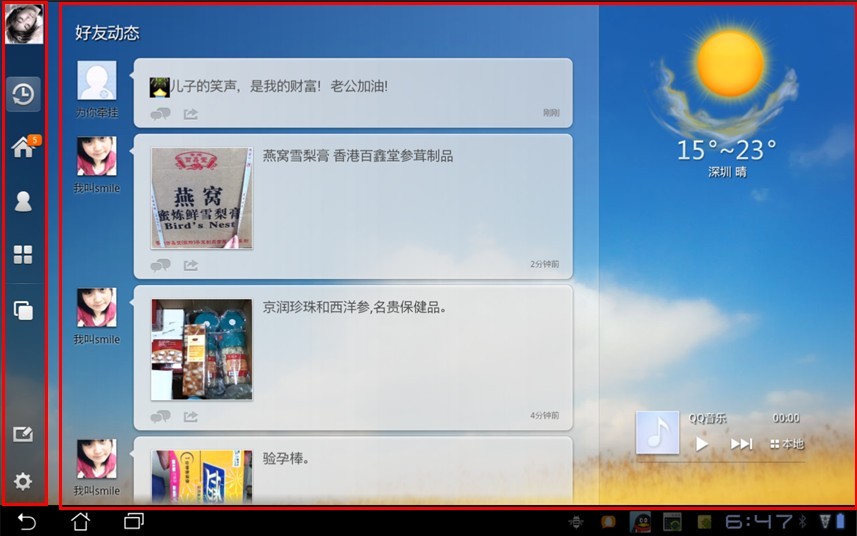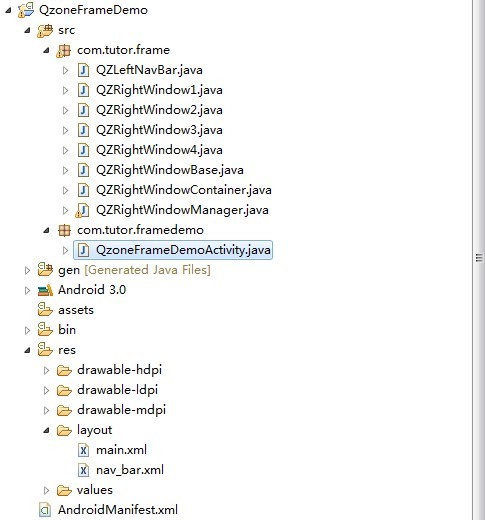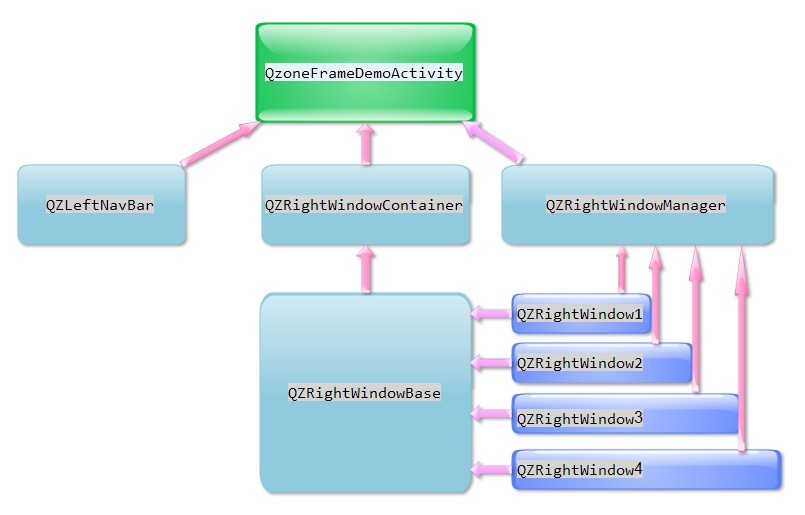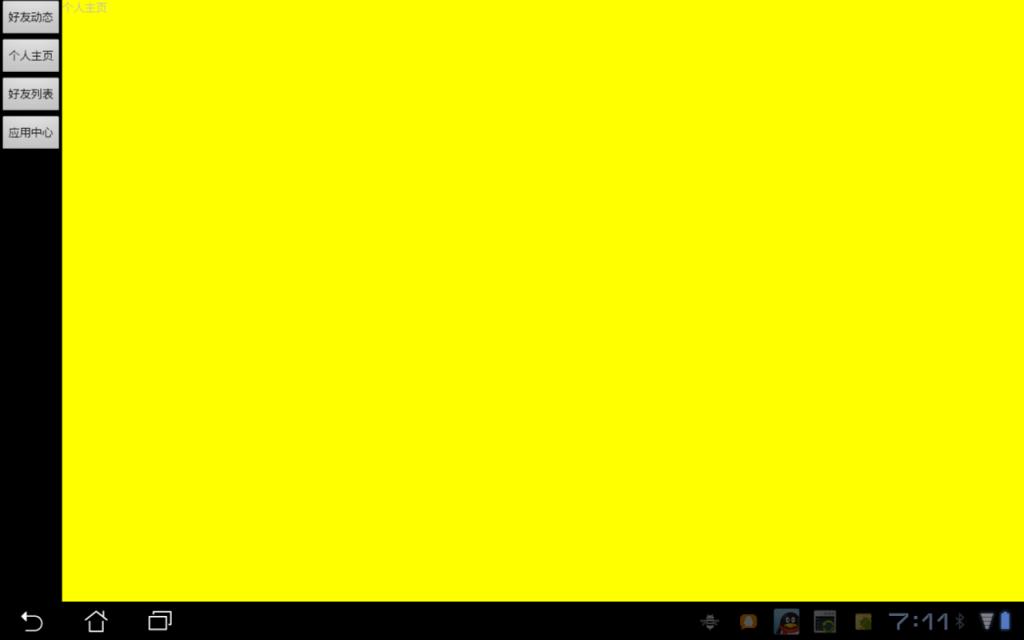大家好,今天是元旦节了,祝大家节日快乐!今天给大家分享的是Apad Qzone的UI框架,我们首先看下交互图如下:

图1:交互效果图.
从上图可以看出,整个应用其实UI框架相对比较简单,可以分为俩部分,左侧导航栏区域,右侧显示内容区域。当我们点击左侧导航栏时,右侧显示相对应内容。
应用的主要内容分为四个模块:好友动态;个人主页;好友列表;应用中心。右侧显示内容则统一由一个管理器管理,管理器管理了右侧的容器以及显示内容面板。
也许用文字不太好说清楚,所以我写了一个简单的Demo以及画了一个UI结构图方便大家理解:
首先是新建一个Android工程,命名为QzoneFrameDemo,结构如下:

图2:程序代码结构图:
为了更容易理解代码,我画了一个各个类的关系图如下:

上图可以清晰的看清各个类之间的关系,其中QZRightWindowManger管理了QZRightWindowContainer(剪头忘记加了)和右侧的四个Window,QZRightWindowContainer继承了FrameLayout,四个Window继承了QZRightWindowBase。
其中QZRightWindowContainer代码如下(继承了FrameLayout):
- package com.tutor.frame;
- import android.content.Context;
- import android.util.AttributeSet;
- import android.widget.FrameLayout;
- public class QZRightWindowContainer extends FrameLayout {
- public QZRightWindowContainer(Context context){
- super(context);
- }
- public QZRightWindowContainer(Context context, AttributeSet attrs) {
- super(context, attrs);
- }
- }
而右侧四个Window的基类QZRightWindowBase的代码如下:
- package com.tutor.frame;
- import android.content.Context;
- import android.util.AttributeSet;
- import android.widget.FrameLayout;
- import android.widget.TextView;
- public abstract class QZRightWindowBase extends FrameLayout {
- public TextView mContentTextView;
- private LayoutParams params = new LayoutParams(LayoutParams.FILL_PARENT,
- LayoutParams.FILL_PARENT);
- public QZRightWindowBase(Context context){
- super(context);
- setupViews();
- }
- public QZRightWindowBase(Context context, AttributeSet attrs) {
- super(context, attrs);
- setupViews();
- }
- private void setupViews(){
- mContentTextView = new TextView(getContext());
- mContentTextView.setLayoutParams(params);
- }
- //做些事为了扩展举例而已
- public abstract void dosomething();
- //做些事2
- public abstract void dosomething2();
- }
- package com.tutor.frame;
- import android.content.Context;
- import android.graphics.Color;
- import android.util.AttributeSet;
- public class QZRightWindow1 extends QZRightWindowBase{
- public QZRightWindow1(Context context){
- super(context);
- setupViews();
- }
- public QZRightWindow1(Context context, AttributeSet attrs) {
- super(context, attrs);
- setupViews();
- }
- private void setupViews(){
- mContentTextView.setText("好友动态");
- mContentTextView.setBackgroundColor(Color.RED);
- addView(mContentTextView);
- }
- @Override
- public void dosomething() {
- // TODO Auto-generated method stub
- }
- @Override
- public void dosomething2() {
- // TODO Auto-generated method stub
- }
- }
管理QZRightWindowContainer和右侧四个Window的管理类QZRightWindowManager代码如下:
- package com.tutor.frame;
- import java.util.HashMap;
- import java.util.Iterator;
- import android.view.View;
- public class QZRightWindowManager {
- /**
- * 好友动态面板的KEY
- */
- public static final int FRIEND_TRENDS_WINDOW = 0;
- /**
- * 个人中心面板的KEY
- */
- public static final int HOME_PAGE_WINDOW = 1;
- /**
- * 好友关系链面板的KEY
- */
- public static final int FRIEND_LIST_WINDOW = 2;
- /**
- * 应用中心面板的KEY
- */
- public static final int APP_CENTER_WINDOW = 3;
- private HashMap<Integer, QZRightWindowBase> mHashMap;
- private QZRightWindowContainer mContainer;
- public QZRightWindowManager(){
- mHashMap = new HashMap<Integer, QZRightWindowBase>();
- }
- public void setmContainer(QZRightWindowContainer container) {
- this.mContainer = container;
- }
- public void showRightWindow(int num,QZRightWindowBase mQzRightWindowBase){
- if(!mHashMap.containsKey(num)){
- mHashMap.put(num, mQzRightWindowBase);
- if(!(mQzRightWindowBase instanceof QZRightWindow1)){
- mContainer.addView(mQzRightWindowBase);
- }
- }
- for (Iterator iter = mHashMap.keySet().iterator(); iter.hasNext();) {
- Object key = iter.next();
- QZRightWindowBase qzb = mHashMap.get(key);
- qzb.setVisibility(View.INVISIBLE);
- }
- mQzRightWindowBase.setVisibility(View.VISIBLE);
- }
- }
主程序QzoneFrameDemoActivity代码如下:
- package com.tutor.framedemo;
- import com.tutor.frame.QZLeftNavBar;
- import com.tutor.frame.QZRightWindow1;
- import com.tutor.frame.QZRightWindow2;
- import com.tutor.frame.QZRightWindow3;
- import com.tutor.frame.QZRightWindow4;
- import com.tutor.frame.QZRightWindowBase;
- import com.tutor.frame.QZRightWindowContainer;
- import com.tutor.frame.QZRightWindowManager;
- import android.app.Activity;
- import android.os.Bundle;
- import android.view.View;
- import android.view.View.OnClickListener;
- public class QzoneFrameDemoActivity extends Activity implements OnClickListener{
- private QZRightWindow1 mQzRightWindow1;
- private QZRightWindow2 mQzRightWindow2;
- private QZRightWindow3 mQzRightWindow3;
- private QZRightWindow4 mQzRightWindow4;
- private QZLeftNavBar mQzLeftNavBar;
- private QZRightWindowContainer mQzRightWindowContainer;
- private QZRightWindowManager mQzRightWindowManager;
- @Override
- public void onCreate(Bundle savedInstanceState) {
- super.onCreate(savedInstanceState);
- setContentView(R.layout.main);
- setupViews();
- }
- private void setupViews(){
- mQzRightWindowManager = new QZRightWindowManager();
- mQzLeftNavBar = (QZLeftNavBar)findViewById(R.id.navbar);
- mQzLeftNavBar.findViewById(R.id.rw1).setOnClickListener(this);
- mQzLeftNavBar.findViewById(R.id.rw2).setOnClickListener(this);
- mQzLeftNavBar.findViewById(R.id.rw3).setOnClickListener(this);
- mQzLeftNavBar.findViewById(R.id.rw4).setOnClickListener(this);
- mQzRightWindow1 = (QZRightWindow1)findViewById(R.id.qzrw1);
- mQzRightWindowContainer = (QZRightWindowContainer)findViewById(R.id.container);
- mQzRightWindowManager.setmContainer(mQzRightWindowContainer);
- }
- private void showRightWindow(int num,QZRightWindowBase mQzRightWindowBase){
- mQzRightWindowManager.showRightWindow(num, mQzRightWindowBase);
- }
- @Override
- public void onClick(View v) {
- int id = v.getId();
- switch (id) {
- case R.id.rw1:
- showRightWindow(QZRightWindowManager.FRIEND_TRENDS_WINDOW, mQzRightWindow1);
- break;
- case R.id.rw2:
- if(mQzRightWindow2 == null){
- mQzRightWindow2 = new QZRightWindow2(this);
- }
- showRightWindow(QZRightWindowManager.HOME_PAGE_WINDOW, mQzRightWindow2);
- break;
- case R.id.rw3:
- if(mQzRightWindow3 == null){
- mQzRightWindow3 = new QZRightWindow3(this);
- }
- showRightWindow(QZRightWindowManager.FRIEND_LIST_WINDOW, mQzRightWindow3);
- break;
- case R.id.rw4:
- if(mQzRightWindow4 == null){
- mQzRightWindow4 = new QZRightWindow4(this);
- }
- showRightWindow(QZRightWindowManager.APP_CENTER_WINDOW, mQzRightWindow4);
- break;
- default:
- break;
- }
- }
- }
主程序所用到的布局文件main.xml代码如下:
- <?xml version="1.0" encoding="utf-8"?>
- <LinearLayout xmlns:android="http://schemas.android.com/apk/res/android"
- android:layout_width="fill_parent"
- android:layout_height="fill_parent"
- android:orientation="horizontal" >
- <com.tutor.frame.QZLeftNavBar
- android:id="@+id/navbar"
- android:layout_width="wrap_content"
- android:layout_height="fill_parent"/>
- <com.tutor.frame.QZRightWindowContainer
- android:id="@+id/container"
- android:layout_width="fill_parent"
- android:layout_height="fill_parent"
- >
- <com.tutor.frame.QZRightWindow1
- android:id="@+id/qzrw1"
- android:layout_width="fill_parent"
- android:layout_height="fill_parent"
- />
- </com.tutor.frame.QZRightWindowContainer>
- </LinearLayout>
运行效果如下:

效果1

效果2.
OK,这样就大功告成了!对于pad上面的应用,单Activity化,各个功能模块化,UI控件化,是比较好的选择,这样可以加大开发效率,减少和其他同学的耦合性。
下面的链接是源代码,供新手们学习用,今天就讲到这里,谢谢大家!!!























 被折叠的 条评论
为什么被折叠?
被折叠的 条评论
为什么被折叠?








